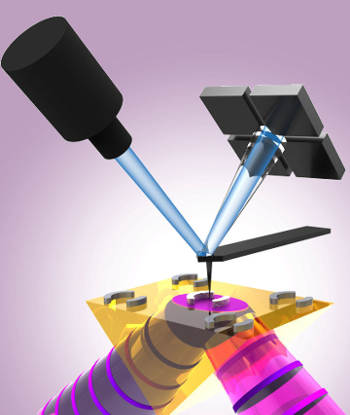Oct 9 2014
Anasys Instruments reports on the new AFM-IR results from the Energy Research Group at NIST just published in the journal for Advanced Optical Materials. The paper is entitled “Nanoscale imaging and spectroscopy of plasmonic modes with the PTIR technique.”
 Schematic showing the photothermal induced resonance (PTIR) technique: this combines the lateral resolution of atomic force microscopy (AFM) with the chemical specificity of IR spectroscopy. A wavelength-tunable, pulsed IR laser (purple) illuminates a sample consisting of plasmonic gold resonators from the below. The resulting thermal expansion of the sample is detected locally by the AFM cantilever tip, which is monitored by reflecting a laser (blue) off the back of the cantilever. (Image reproduced courtesy of NIST)
Schematic showing the photothermal induced resonance (PTIR) technique: this combines the lateral resolution of atomic force microscopy (AFM) with the chemical specificity of IR spectroscopy. A wavelength-tunable, pulsed IR laser (purple) illuminates a sample consisting of plasmonic gold resonators from the below. The resulting thermal expansion of the sample is detected locally by the AFM cantilever tip, which is monitored by reflecting a laser (blue) off the back of the cantilever. (Image reproduced courtesy of NIST)
Researchers from the NIST Center for Nanoscale Science and Technology (CNST) and the University of Maryland have used photothermal induced resonance (PTIR) to characterize individual plasmonic nanomaterials in order to obtain absorption maps and the first examples of absorption spectra with nanometer-scale resolution. Nanostructuring of plasmonic materials enables engineering of their resonant optical response and creates new opportunities for applications that benefit from enhanced light-matter interactions, including sensing, photovoltaics, photocatalysis, and therapeutics.
Project Leader, Andrea Centrone and his co-workers in the Energy Research Group at NIST used a technique called photothermally induced resonance (PTIR) where an AFM tip is used as an IR absorbance detector thus enabling nanoscale IR spectroscopy. Since the PTIR signal is not affected by scattering, PTIR spectra are free of Fano spectral distortions typically observed in the far-field.
Commenting on the work, Centrone says “we showed that PTIR characterization is not just applicable to organics, insulators and semiconductors, as demonstrated previously, but that metals are also amenable to it. This is an important step forward for applying the PTIR technique to a wider variety of functional devices.”
PTIR is at the core of the nanoIR platform developed and supplied by Anasys Instruments for this work. Now in its second generation, the nanoIR2 combines key elements of both nanoscale IR spectroscopy and atomic force microscopy (AFM) to enable IR spectroscopy and imaging on the nanoscale. In addition to revealing chemical composition, the nanoIR2 system provides high-resolution characterization of local topographic, mechanical, and thermal properties. Potential application areas span the realms of polymer science, materials science, and life science, including detailed studies of structure property correlations.
About Anasys Instruments
Anasys Instruments designs breakthrough, award-winning products that deliver nanoscale probe based analytical techniques while providing high quality AFM imaging. We pioneered nanoscale IR spectroscopy, nanoscale thermal analysis and wideband nanoscale dynamic mechanical spectroscopy. For further details, please visit http://www.anasysinstruments.com/